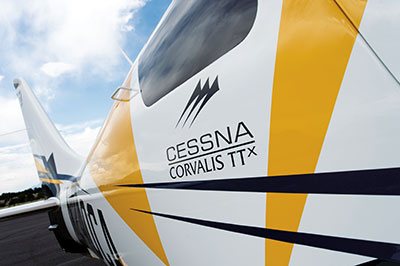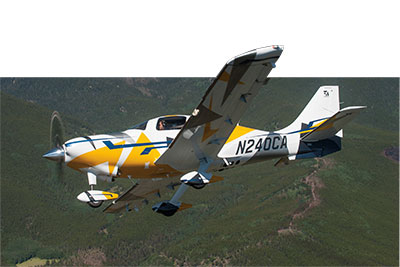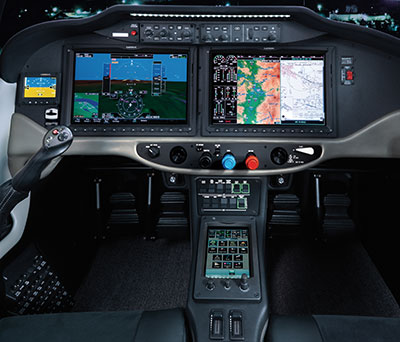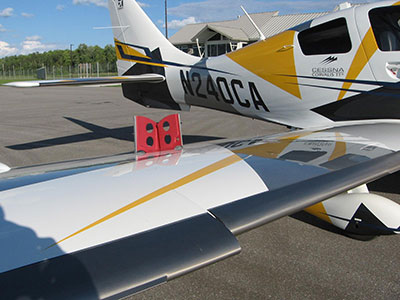
Features
Operations
New Corvalis is really improved
While new models of popular light planes often differ little from the previous model, Cessna’s new Corvalis TTx stands out.
May 6, 2013 By Neil A. MacDougall
While new models of popular light planes often differ little from the previous model, Cessna’s new Corvalis TTx stands out. It has the same sleek lines, beguiling gull-wing doors and ramp appeal of the Corvalis 400, but the cockpit’s sports car feel, avionics, pilot-friendly features and Citation jet upholstery put it in a new class.
 |
|
| The TTx comes equipped with two 60-amp alternators and two 15-amp-hour batteries. Photo: Cessna
|
Garmin G2000’s two 14-inch screens, one for the primary flight and the other multi-function, are eye-poppers. Displays are crisp, colourful and readable in any light. The multi-function display (MFD) can be split to show engine gauges, GPS and charts simultaneously. The G2000 is like an automatic transmission compared to the G1000’s stick shift. Knobs and keys are replaced by a more intuitive smartphone-like controller located between the front seats. Radios, checklists, flight plans, weather, traffic, charts, direct-to and utilities are accessed by a touchscreen. An infrared system activates before a screen is touched, eliminating smears on the glass. You can even read the names on the side-wall fuses.
The fully integrated Garmin EFIS includes dual attitude and heading reference systems, Mode S transponder with traffic information, dual nav-com/GPS/WAAS, terrain awareness system (TAWS-B), electronic checklist, synthetic vision, Garmin SafeTaxi and FliteCharts, Garmin GFC-700 autopilot and electronic stability and protection (ESP). Cessna says the ESP applies control pressure to “nudge” the pilot closer to safe speeds, bank or descent rates. Pilots of many old airliners and military aircraft would drool at such capabilities.
Having experienced two electrical failures during night cross-countries, I am a fan of suspenders. The TTx has two 60-amp alternators, two 15-amp-hour batteries and no cranky vacuum pump. In the event of an electrical failure, the pilot does not need to shed electrical load. Additional support comes from the new digital L3 Triology, which shows attitude, altitude and airspeed in a single instrument, replacing three conventional analogue ones.
I had a chance to sample the TTx (for twin turbo) at Toronto-Buttonville during the plane’s visit last year. The TTx is average on the first count, but the bolts on the doors appear as big as those on a bank vault. The satisfying closing “thunk” assures you of their security. A pneumatic seal eliminates leaks and reduces noise.
The cockpit is 49 inches (1.24 metres) wide and everything is comfy and handy. Leather-wrapped side sticks pivot around a single point, unlike other side controllers, which slide. They seemed more natural than the controls in the Cirrus, Davis DA 2 and Airbus A320.
 |
|
| The Corvalis TTx has a maximum cruising speed of 235 ktas.
|
A castoring noise wheel makes parking and taxiing easy. Excessive brake use has caused fires in other aircraft so Cessna has designed the gear to minimize fire risk. The takeoff was sprightly but the rate of climb was kept to 1,200 feet per minute in order to improve the view. Controls are well harmonized. At 9,500 feet and 80 per cent power we cruised at 192 knots true air speed. The air was smooth, but the plane’s high wing loading should provide a superior ride in turbulence. During a stall, the ailerons were fully effective, due to the wing cuff and unspecified “elevator features.”
There was no wing drop. Hand flying non-precision approaches is simplified by the plane’s stability and the avionics, which offered aural warnings like “turn to 277 degrees in three seconds” on the RNAV approach to Barrie-Orillia. We did not need the spoilers that allow you to maximize time at cruising altitude without shock-cooling the engine during descents. Altogether the Cessna Corvalis TTx is a sturdy machine as confidence-inspiring as the Socata TBM 700.
The TTx is certified in the FAA’s utility category (4.4 to -1.76Gs) rather than the less demanding and usual normal category (3.8 to -1.52Gs). Each of the two wing spars can support the full load limit of the aircraft. The spars also protect the fuel cells from rupture carbon fibre is used widely because it is up to three times as strong as the same weight of aluminum. Design life of the airframe is 25,000 hours. High manoeuvring (158 knots indicated air speed) and ability to never exceed (230 knots indicated air speed) speeds are further evidence of the plane’s sturdy construction.
 |
|
| The TTx features two 14-inch screens: one for primary flight and the other able to perform multiple functions. Photo: Cessna |
Cessna test pilots reportedly spun the TTx over 500 times and met the FAA requirements. Perhaps fearing that some loony would spin the plane, Cessna has not applied for certification. This decision – which Cessna has not explained – allows competitor Cirrus Aircraft to advertise that neither plane is spin certified, though Cirrus models can’t be spun and require a parachute to be airworthy. Talk about turning a shortcoming into an advantage!
According to Aviation Consumer magazine, the Cirrus SR20 and 22 have a fatal accident rate of 1.6 per 100,000 hours while the Columbia/Corvalis have a rate of 1.0.
A Columbia sales rep who used to sell the Cirrus told me he much preferred the Columbia. He was frustrated that his prospects, many of them doctors, liked the Columbia, but bought a Cirrus because their wives wanted parachutes.
TTx safety features include seatbelt airbags and proprietary three-point seatbelts that transmit lower loads to occupants than typical four-point harnesses. A built-in CO-pulse oximeter reads your blood oxygen level and pulse rate as soon as you put your finger in a hole in the panel. It’s a neat way to check your personal serviceability and the built-in oxygen system.
The latest FAA standards require light planes to have rollover protection for the occupants. That includes a mallet for breaking windows. Seats must stand vertical loads of 19Gs and a horizontal load of 26Gs. IFR note aircraft must have lightning protection, which the TTx does.
The sturdy structure of the roll cage results in wide windshield pillars that block the view. Monitoring these blind spots on even a short flight is a nearly impossible task, except in Diamond’s piston-engine aircraft whose pillars are further aft.
The TTx’s deep panel also makes the aural traffic reporting service essential.
The TTx is powered by a 310-horsepower Continental TSIO-550-C turbocharged engine. Recommended time between overhauls is 2,000 hours or 12 years, whichever occurs first. Flying such engines with the mixture lean-of-peak was thought to damage the engines; about 10 years ago Continental found that lean-of-peak operation was safe, if the pilot enriched the mixture before adding power.
Operating lean-of-peak slows speed five to eight knots but saves five gallons of fuel per hour. Maximum cruise power is 85 per cent.
 |
|
| During a stall, the ailerons were fully effective, due to the wing cuff and unspecified “elevator features.” Photo: Cessna
|
When even air conditioning is standard, few options are needed. The most popular is the $25,750 TKS weeping-wing system for flight into known icing. The 65-pound weight includes two wing lights and glycol for 2.5 hours. Other options are a tactical weather detection system, iridium satellite transceiver, distance measuring equipment and automatic direction finder.
Three days of training are included in the plane’s U.S. $733,950 price. Twelve hours of ground school emphasize systems and how to cope with failures. About 11 hours of VFR and IFR flying training follow. A buyer’s instructor can take the ground school free.
Most buyers of the 795 Corvalises sold have also owned a Cessna 210, 206 or 182, although a few have had a Mooney, Cirrus or light twin, according to demo pilot Jeremy Schrag.
Although the TTx can reach flight level 20 in 19 minutes, many owners flight plan for 8,000 or 9,000 feet because of the inconvenience of masks and the cost and erratic availability of oxygen, he added. Oh well, drivers of many four-wheel-drive SUVs don’t use their capabilities either.
The TTx has superior speed and range, marvellous equipment, fine flying characteristics and lots of pizzazz. It may not be a Cirrus killer, but it’s a formidable competitor.
Cessna T240 Corvalis TTx
–preliminary figures from Cessna |